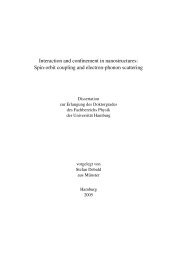Measuring the Electron Beam Energy in a Magnetic Bunch ... - DESY
Measuring the Electron Beam Energy in a Magnetic Bunch ... - DESY
Measuring the Electron Beam Energy in a Magnetic Bunch ... - DESY
Create successful ePaper yourself
Turn your PDF publications into a flip-book with our unique Google optimized e-Paper software.
Chicane R 56 (mm) R 16 (mm) X (mm)<br />
range<br />
DX (mm)<br />
+3 sigma<br />
FLASH BC2 140-228 284-358 0-74 2-10<br />
FLASH BC3 14-84 100-250 0-150 2-6<br />
XFEL BC1 100 500-600 0-400 2-60<br />
XFEL BC2 40 200-300 0-400 2-9<br />
Table 2.3.1<br />
R 56 and R 16 values for FLASH and XFEL, <strong>the</strong> correspond<strong>in</strong>g dynamic<br />
apertures of <strong>the</strong> chicanes (X range) and <strong>the</strong> position spreads of <strong>the</strong> beam<br />
with<strong>in</strong> <strong>the</strong> chicanes (DX). The X range starts at zero for all of <strong>the</strong> bunch<br />
compressors, because it is desirable to allow for operation with <strong>the</strong><br />
compressors off.<br />
Whereas at LCLS (L<strong>in</strong>ac Coherent Light Source at SLAC) [13], ano<strong>the</strong>r FEL<br />
facility, <strong>the</strong> entire bunch compressor beam pipe was placed on motorized movers <strong>in</strong> order<br />
to accommodate different compression modes, <strong>the</strong> FLASH and XFEL bunch compressors<br />
have wide and flat vacuum chambers that do not move. The reasons for build<strong>in</strong>g chicanes<br />
that have adjustable properties are twofold: it is sometimes desirable to turn <strong>the</strong> chicane<br />
off for a different mode of mach<strong>in</strong>e operation and it may be desirable to have <strong>the</strong> freedom<br />
to <strong>in</strong>dependently adjust <strong>the</strong> bunch length and energy chirp emerg<strong>in</strong>g from <strong>the</strong> chicane.<br />
The limitation of <strong>the</strong> adjustable range of a bunch compressor is not determ<strong>in</strong>ed by<br />
<strong>the</strong> feasibility of construct<strong>in</strong>g large aperture diagnostics, which are <strong>the</strong> subject of this<br />
<strong>the</strong>sis, but <strong>in</strong>stead, by <strong>the</strong> feasibility of construct<strong>in</strong>g dipole magnets with a high field<br />
quality over <strong>the</strong> entire dynamic aperture. Rectangular bends are used and as <strong>the</strong> field<br />
quality deteriorates at <strong>the</strong> outer limits of <strong>the</strong> dynamic aperture, chromaticity and higher<br />
order dispersion may have to be corrected due to <strong>the</strong> quadrupole and sextupole field<br />
errors conta<strong>in</strong>ed <strong>the</strong>re<strong>in</strong>. With a chicane on movers, <strong>the</strong> field tolerances on <strong>the</strong> dipole<br />
magnets are reduced and it is easier to add quadrupole magnets to <strong>the</strong> chicane <strong>in</strong> order to<br />
correct <strong>the</strong> chromaticity of <strong>the</strong> beam.<br />
The energy spread of a bunch is unaffected by <strong>the</strong> bunch compression process<br />
and can be used to fur<strong>the</strong>r compress <strong>the</strong> bunch <strong>in</strong> multiple bunch compressor stages until<br />
a m<strong>in</strong>imum bunch length is reached. The m<strong>in</strong>imum bunch length for a given energy<br />
spread is taken from <strong>the</strong> second term of Eq. 2.3.9<br />
σ<br />
z m<strong>in</strong><br />
= R56<br />
Eiσ<br />
E<br />
E<br />
f<br />
It is not, however, always desirable to reach this value <strong>in</strong> one bunch compressor alone.<br />
<strong>Bunch</strong> compression is not typically done <strong>in</strong> only one stage because of non-l<strong>in</strong>ear<br />
energy spread, wakefield and space-charge issues. At FLASH, <strong>the</strong> bunch is shortened two<br />
times, once at 130 MeV and aga<strong>in</strong> at about 460 MeV. When <strong>the</strong> bunch is highly<br />
compressed, <strong>the</strong> space-charge forces become stronger and force <strong>the</strong> beam to expand.<br />
When <strong>the</strong> beam is not longitud<strong>in</strong>ally compressed enough, <strong>the</strong> non-l<strong>in</strong>earity of <strong>the</strong> energy<br />
14

















